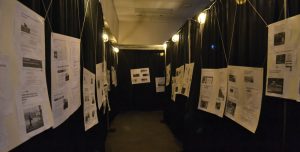
Photo by Cenn Hall
Bradley hosted its sixth Tunnel of Oppression event since 2005 this past Tuesday through Thursday, in the Michel Student Center Ballroom. The Tunnel of Oppression is a national program started in the 1990s. It was the first tunnel of Opression event at Bradley in three years.
Nine tunnels were used this year to cover a wide range of current issues including sexual assault, student loan debt, the stigma of mental illness, African American women and their experiences with law enforcement, transgender bathrooms, the immigration experience for Latinos, the rise of anti-Semitic violence, body image and privilege.
“One of the main goals for the Tunnel is to give individuals who have lived experiences an opportunity and a platform to showcase and share their message,” Norris Chase, executive director of the Office for Diversity and Inclusion, said.
According to Chase, the Tunnel’s main purpose is to expose students to the multiples issues and topics that others deal with on a day-to-day basis. He said he hopes the Tunnel will cause students to rethink issues or take action.
“If you leave this Tunnel and this experience with one more question, one inclination to take action, one more dose of energy to say, ‘I want to learn more about that,’ then we’ve done our job,” Chase said.
Chase helped develop the Tunnel of Oppression through a planning committee. Preparation for the event began in March and brought department leaders and students together to collaborate. Each specific section within the Tunnel had its own group of organizers.
“The event has been planned by some of the greatest minds on campus. The volunteers are phenomenal. Our planning committee is phenomenal,” Chase said. “I really believe that this event will create conversations at Bradley to enhance our campus community.”
Student volunteers partook in the Tunnel as tour guides and actors for each individual tunnel.
“I got to create my own tunnel,” Monica Youssef, a senior marketing major and student volunteer, said. “I think it is very important for students to go through the tunnel because we’re highlighting issues of oppression. Having worked on a tunnel, there were issues that I wasn’t even aware of and this was an opportunity to educate myself.”
All volunteers were taken through a brief training process to understand the issues they were displaying and how to deal with a visitor’s discomfort.
“The idea of discomfort and being wrong is not the message we want to send,” Chase said. “When you’re uncomfortable to a point where you can understand the way you’re uncomfortable, you grow the most.”
According to Youssef, taking part in the construction of Tunnel of Oppression was a great opportunity to identify ways to improve society.
“Different groups of people are oppressed for different reasons and if you’re not, you have a privilege,” Youssef said. “Identifying our privileges shouldn’t be a burden because our privileges give us power to make a difference. I hope that people leave the tunnel educated on different issues and are empowered to make a difference.”
Following the 20-minute tours, students participated in a discussion with a faculty member. The Tunnel of Oppression was met with so much interest that registrations were full for all tours.
“We had to implement a waiting list, which is not a bad problem to have, but it does disappoint me that we can’t give all students the experience of going through the Tunnel of Oppression,” Chase said.
Those who missed the Tunnel of Oppression can visit the Office of Diversity and Inclusion for workshops and opportunities to expand cultural awareness and expand the ability to create an inclusive environment.




—-the stigma of mental illness
Raising awareness.
Do you want to raise our awareness that there are people who direct a stigma at mental illnesses, or make us aware you are among them?
History offered great support for rape/stigma and for Jew/stigma. Both were very dark tunnels for a great many people.
Raise your awareness a little higher.